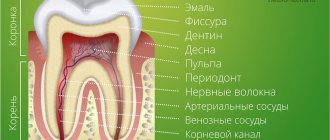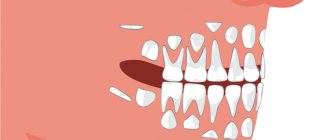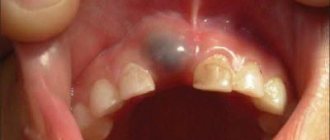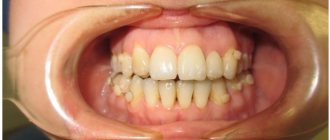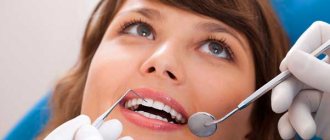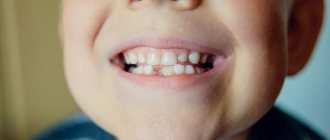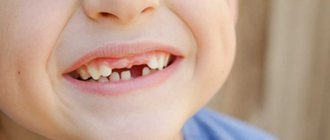Signs that make it easy to determine a person’s character by their teeth
Shape of teeth
says a lot about a person, and you can determine
the type of person by his teeth
by paying attention to the following signs of the dentition:
Upper incisors
| People with long incisors They are usually the life of the party, but at the same time they persistently strive for their goals and are quite open in communicating with others. Large incisors most often occur in adamant, stubborn people who persistently pursue their goal. Despite their difficult nature, those with large teeth are distinguished by their sincerity. Large gap between teeth betrays the explosive nature of their owner. In addition, the hole indicates an addiction to risk, which is not always justified. |
Fangs
It is generally accepted that large, sharp teeth
, including fangs, speak of a person’s aggressiveness. In fact, this is not always the case. In most cases, such teeth reveal a loving person. They can also talk about determination.
For example, if a woman’s upper canines are large and long
, then this can emphasize her kindness and humor.
Evenness of teeth
| A person's character can be determined by the curvature or straightness of their teeth. Ideal dentition speaks of a balanced, calm character. Such people are not afraid to make decisions and take responsibility. They are eloquent, self-confident and ready to go towards their goal no matter what. Uneven teeth speaks of the good intuition of the owner of the teeth. |
A person’s small, fox-like teeth can also tell about a person’s character.
— owners of such dentition are often characterized by lust.
Protruding teeth
characteristic of stingy people.
Teeth size
Strong large teeth
testify to a person’s courage, strength and kindness. Such people are most often long-livers.
| They will tell you what character the girl has and small teeth - often their owners are quite secretive and reserved natures. They have a small number of friends. Often people around them simply do not understand them, considering them strange. What do sparse teeth a person does not need to think for long - such teeth indicate people with a wild imagination, who always have a fresh, interesting idea in their heads: they can often even be considered strange. They are also distinguished by their tenacity of character and always go towards their goal. |
Small teeth
, among other things, can talk about greed. Such people have a hard time parting with money and are certainly not ready to spend it on others, be it relatives or friends.
Presence of damage
The presence of damage to the dentition can also indicate the character of a person
So, if
the upper row of teeth is damaged
, this will indicate difficulties in unlocking your potential, and if there are
problems in the lower part (especially in the left)
, you should think about problems in family relationships.
Why are teeth in the wrong position?
Three main reasons:
Teeth may naturally be large, but the jawbone may be small. If the teeth do not have enough space in the row, they erupt, protruding forward or backward (in this case, those teeth that erupted earlier appear to be protruding). If the space for a tooth is severely narrowed, it may not grow fully (have insufficient crown height) or may not appear at all. Such a tooth, which is in its infancy, is called impacted. It can be seen on a CT scan.
Fangs erupt at 9–12 years of age. The later, the greater the likelihood that they will be positioned incorrectly.
If by the time of teething a malocclusion has already been formed, then the teeth will tend to occlude correctly, even if they are uneven relative to each other.
If baby teeth are not properly cared for and caries are not treated, they may fall out prematurely. The space in the row of teeth will be reduced, because in childhood all tissues are elastic, and the teeth always tend to close if gaps appear. Permanent teeth may begin to erupt in the wrong direction.
Those who have protruding canines often have large teeth themselves. Therefore, after treatment by an orthodontist, the smile looks very attractive.
Often there is simply not enough space for fangs
In what cases do the fangs protrude forward?
This is one of the most common disorders that orthodontists work with. It's all a matter of teething order. The upper teeth, each of which has a serial number, appear as follows: 1st incisor, 2nd incisor, 1st premolar, canine. That is, the canine, which occupies a place near the lateral incisor, must grow in the space that remains after the eruption of the premolar. If there is not enough space, then the tooth cannot stand straight.
This is the order in which the permanent upper teeth grow.
Types of crowding
Primary and secondary crowding of teeth can be distinguished. Primary crowding of teeth is associated with a hereditary discrepancy between the size of the jaw and the size of permanent teeth. Secondary crowding appears due to the influence of other factors, such as, for example, the presence of supernumerary teeth, early removal of baby teeth.
Dentists distinguish only 4 degrees of crowding of the dentition. Mild severity is characterized by a lack of space within 3 mm, the teeth are evenly spaced with slight deviations. With moderate severity, the space deficit is already 3 mm, one tooth is in an incorrect position. In severe cases, the lack of space is already about 5 mm; two teeth may be located outside the dentition. With severe crowding, the lack of space for teeth in the jaw exceeds 5 mm, and all teeth are in the wrong position.
Can crowded teeth be treated without braces?
Yes, treatment without braces is acceptable. If the patient does not want to get braces, or there are objective medical reasons for this, it is recommended to treat the defect using tooth separation. The lateral interdental areas are lightly ground at each edge. As a result, it is possible to obtain the previously missing three millimeters to straighten the dentition. Also, if teeth are slightly crowded, specialists may suggest installing veneers or lumineers. Dentists specialize in treating crowded teeth with braces, aligners, and other effective techniques. An integrated approach to solving the problem, maximum preservation of the health of your teeth, ideal results in a short period of treatment. Schedule a consultation today to enjoy a healthy, beautiful smile in no time.
You can also see with your teeth
In 2000, a woman in the United States underwent a unique operation. Sharon Thornton lost her vision due to Stevens-Johnson syndrome, which destroys cells on the surface of the eye. Doctors suggested restoring the woman’s vision using… a tooth. She had a fang removed, into which an artificial lens was inserted and implanted in her left eye. A day later, the blind woman was able to see the world again.
Causes of pathology
The reasons may be different:
- Irregularly shaped teeth.
- Improper jaw development.
- Underdevelopment of dental arches; excessive development of teeth or, conversely, very small teeth.
- Poor heredity in terms of jaw formation and tooth growth.
What is crowded teeth in children and adults, and why does it occur?
Crowding of teeth is a common problem in which the dental units are located too close to each other, some crowns “overlap” the bottoms of the neighboring ones, forming an unaesthetic picture.
Teeth can be crowded in the middle, on the sides, and also in both the back and frontal areas at the same time. Most often, dentists diagnose crowding of the front teeth of the lower jaw.
There are three stages of dental crowding:
- Third or advanced, when the dental arch decreases in size by approximately 7 millimeters;
- The middle stage of dental crowding, when the row of teeth is shortened by 4 - 6 millimeters;
- Initial or first, when the size of the dental arch is reduced by 2 - 3 millimeters.
How to correct the position of teeth?
During childhood and adolescence there is great potential for growth, including in the jawbone. Therefore, at 10–12 years old, removable orthodontic plates can help. By applying constant pressure, they correct the position of the teeth. But in case of serious violations, when the fangs are located literally on top of the other teeth, only a permanent brace system can help them get into place.
Plate and braces: pros and cons
Removable orthodontic plate
– Costs more than a plate
+ Easier to maintain hygiene
– Maintaining good hygiene requires control and motivation
– Constantly affects only one direction, there is no way to customize it individually
+ The direction of influence is set by the doctor individually for each patient and is constantly adjusted
– Corrects only minor violations
+ Very effective: corrects any malocclusion and teeth position
– Only works while worn
+ Valid 24 hours a day
– Children often remove plates uncontrollably and even lose
+ Cannot be removed before the end of the treatment period
Crowded teeth are a serious defect that requires treatment.
Crowded teeth are teeth that, due to the lack of space for growth, are arranged so tightly that they overlap each other, sometimes even turning around their axis. Lack of space on the dental arch can occur for several reasons:
- if the jaw bone has not grown to the required size;
- if the tooth turns out to be redundant or has larger dimensions;
- with early loss of a baby tooth, when the vacant space on the arch was not filled with prosthetics;
- in the presence of pathologically located eighth molars;
- as a result of bad habits - prolonged pacifier sucking, which has developed into thumb sucking, mouth breathing, etc.
This pathology needs correction, since food debris accumulates in the spaces between unevenly standing teeth, creeping on top of each other, and a soft plaque is formed, which transforms into hard subgingival deposits. Even with great desire and patience, quality oral care becomes impossible. The consequences are well known: first - caries and periodontal diseases, subsequently - periostatitis, abscesses and fistulas, as well as pathological mobility of teeth and their premature loss. How to deal with a really serious problem?
A dental problem is not just a dental problem
Pain in the quads above and below can be a sign of weak ligaments (shoulder, elbow, wrist, ankle and knee joints), chronic inflammation of the joints (for example, polyarthritis), diseases of the large intestine - diverticulosis, polyposis.
Have your wisdom teeth been bothering you for a long time? Make an appointment not only with the dentist, but also with the cardiologist. Coronary heart disease, congenital heart disease and other cardiac diseases - in terms of wisdom teeth. Plaque and tartar can be a signal of endocrine system disorders, a sign of gastric ulcer.
On a note
You should not go to extremes and see any toothache as a serious disease of the internal organs. It could be ordinary caries and nothing more. After all, the cause of caries can be many different or a combination of several factors: past infectious diseases, stress, lack of microelements, metabolic disorders.
During inflammatory processes in the teeth (caries, pulpitis), pain appears so acute that the person immediately grabs the pills and the pain goes away. It turns out that the signal from the diseased organ was never noticed. And the process of destruction does not slow down, foci of chronic infection arise, which can be a source of more serious disorders in the body (sometimes this can even result in a heart attack, meningitis, sinusitis). In order for the body to work smoothly, you need to contact the dentist in a timely manner. And at the same time, we should not forget that after treating a diseased tooth, it is advisable to examine the organs associated with it.
Source
For hair and skin
Dental disease can lead to alopecia areata (baldness). It affects men and women at any age and occurs in approximately one in a thousand.
| Symptoms | Causes |
| Complete hair loss in limited areas of the skin under long hair, with no inflammation. | Not fully studied. It is believed to be an autoimmune disease. |
Hair follicles are not damaged. In most patients, the hair grows back. But for many, alopecia appears again.
A smooth, graceful oval of the face, curved lips, smooth skin are the merit of healthy teeth. Their premature loss leads to the appearance of “senile” facial wrinkles.
Type of person with partial edentia (lack of teeth):
- Pronounced nasolabial triangle;
- mumbling speech;
- a narrow strip of thin lips;
- drooping corners of the mouth.
Pros and cons of orthodontic treatment
Sometimes patients, theoretically prepared for treatment with a fixed appliance, are surprised: “Is it possible to put braces on one jaw?” One of the few options is precisely the need to get rid of crowding. The disadvantages of this method include the duration of treatment, the discomfort experienced by the patient when wearing the brace system, and the need for regular visits to the attending physician. In some cases, before installing the device, it is necessary to remove wisdom teeth. The benefit is that the teeth are not subjected to preparation, they retain their natural shape and color, and with them the opportunity to stay healthy longer.
How to find out a person's biography?
In the long term, this discovery could help archaeologists reconstruct the biographies of people who lived hundreds of years ago. Or the new technology may begin to be used by forensic scientists. Just imagine - somewhere in the forest the dead body of a man was found, about whom nothing is known. Experts will be able to examine his teeth under a microscope and find out what life events he has encountered. By comparing this data with the biographies of missing people, they may well be able to recognize the person's identity.
Thanks to the teeth, forensic scientists will be able to recognize victims. Still from the series "Gotham"
In general, dental remains are a great help for archaeologists to study the life of ancient people even now. In 2022, we already told how Canadian scientists discovered the profession of an Egyptian woman who lived 4,000 years ago based on the condition of her teeth. The girl's two central incisors were so worn that they formed a wedge shape. And on the remaining teeth of the Egyptian woman, flat abrasions were found. Based on all this, scientists assumed that the girl often had to split reeds with her teeth, but who did she work with? You can find out the answer to this question by reading the material on this topic right now.
The structure of the fangs
On the lingual part of the tooth there is a longitudinal ridge that divides the dental crown into two facets: the lateral part has the largest area. The upper canine has a pronounced crown curvature and root deviation.
The root of the tooth is quite thick and has a shape slightly compressed from the sides. Wider in anteroposterior dimension. The lateral and medial surfaces are very wide and have barely noticeable grooves.
The tooth has one, wide enough and accessible if treatment is necessary, root canal.
The canines located on the lower jaw are smaller in size than the upper ones, and the shape of the crown is close to the upper lateral (side) incisors. They are slightly narrower and longer than the upper canines. The medial surface is in a straight line with the root line. The cutting edge is less pronounced. The distal part of the cutting edge is longer than the medial one.
The labial surface of the lower canines is less convex and pronounced than that of the upper ones, and the lingual surface can be either straight or slightly concave.
The lower fangs have a slightly shorter tooth root than the upper ones, but they have absolutely no differences in shape. In rare cases, anatomical pathology occurs in which the root is divided into two parts.
The canines of both jaws have quite pronounced external differences in the dental crown, but at the same time the dental cavities are very similar.

